Speech A Balance of Payments

Guy Debelle[*]
Deputy Governor
Address to the Economic Society of Australia
Canberra –
- Audio 28.53MB
- Q&A Transcript
- Download 379KB
When I started my working life here in Canberra at the Treasury just over 30 years ago, one of the most prominent macroeconomic issues was the current account deficit. Heated discussions took place about twin deficits, banana republics, consenting adults and whether or not the current account should be an objective for monetary policy.[1] Early on in my Treasury career, in between my radio shows on 2XX, I worked in the Balance of Payments section. There was a whole unit devoted to analysing and forecasting the current account deficit, given its prominence in the economic and political debate.
Today, three decades on and back in Canberra, I am going to again focus on the current account balance and Australia's external position. But the rationale for doing so today is quite different to that in the 1980s. Today, the current account deficit is the smallest it has been as a share of the economy since the 1970s and the trade surplus is about the largest it has been since the 1950s. The payments are the closest to being in balance in decades!
As a result, Australia's net foreign liabilities, that is, how much we owe foreigners less how much foreigners owe us, have been declining for the past decade to be at their lowest as a share of GDP since the early 2000s.[2] And the composition of those liabilities has changed quite significantly. It is markedly different from that in the 1980s. In the 80s, foreign liabilities were often regarded as a significant vulnerability for the Australian economy. I think this risk was overstated. The liabilities were predominantly in Australian dollars, which meant the exchange rate still could work very effectively as a shock absorber. I will explain why later.
It is worth examining how and why Australia's external position has changed over recent decades. The nature and extent of the change is generally underappreciated, and is worth highlighting as the trade surplus and the current account deficit reach multi-decade milestones.
The Current Account
I will start with the current account deficit.
For pretty much all of its modern history, Australia has been a net importer of capital. Because there are a lot of profitable investment opportunities in Australia relative to the size of the Australian savings pool, we have sourced capital from the rest of the world either in the form of debt or equity. This is not because savings in Australia is particularly low; it is about on par with many other advanced economies. Rather, it is because the share of investment in the Australian economy is higher than that in many other advanced economies, and foreigners were attracted by the investment returns on offer.
The counterpart to Australia being a net importer of capital is that the country runs a current account deficit (CAD). Through the 1980s, 1990s and 2000s, the CAD averaged around 4 per cent of GDP. But since 2015, the CAD has narrowed to be currently around 1 per cent of GDP. In the March quarter this year, the deficit was 0.6 per cent of GDP, and it may well be smaller still in the June quarter just past. This is the narrowest the current account has been since the December quarter 1979.
The current account is comprised of two components: the trade balance and the net income balance (Graph 1). The narrowing of the CAD reflects a substantial shift in Australia's trade balance. For three decades, the trade balance was generally in deficit, averaging around 1¼ per cent of GDP from 1980 until 2015. Since then, the trade balance has shifted into surplus. In the March quarter, the surplus amounted to 3 per cent of GDP, the largest surplus since 1973.
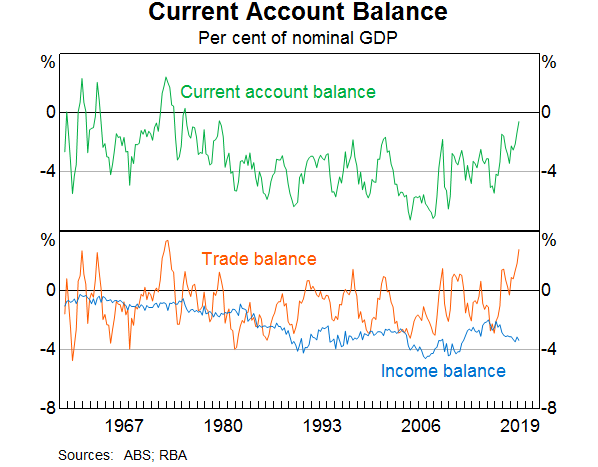
The large surplus reflects a number of dynamics. Two of the primary drivers come from the resources sector. The first is the high revenue from resource exports, both because of the large increase in the volume of resource exports (i.e. how many tonnes Australia exports) as well as the high prices we have recently been receiving for those exports, in particular iron ore. The second is that as the resource investment boom has reached its end, the import of investment goods to boost the capacity in the resources sector (in particularly the LNG sector) has declined considerably. The extra revenue has bolstered national saving and resource investment has declined considerably over the past five years. This is a major reason why the gap between investment and saving has declined to its lowest in a long time, which, if you remember your national accounting identities, is directly equivalent to the current account being at multi-decade lows.
But the trade balance story is not just a resources story. There has been strong growth in exports of education and tourism. The share of services in Australia's exports has increased from 17 per cent in the 1980s to 21 per cent now. The other noteworthy development of late has been the strong growth in manufactured exports. These include pharmaceutical goods and medical devices, and have grown by 15 per cent over the past two years.
The other part of the current account is the net income balance. The net income balance is the difference between how much it costs to service the country's foreign liabilities (for example, interest payments on foreign debt) and the earnings on Australia's foreign assets (for example, dividend payments to residents from foreign share holdings). The income balance has widened a little in recent years, but is around the middle of the range it has been in since the late 1980s at 3.4 per cent of GDP. I will come back to this later.
Net Foreign Liabilities
Each quarter that Australia funds its current account deficit with net borrowing from the rest of the world, we gradually add to the stock of net foreign liabilities (NFL) we owe to the rest of the world. As Australia ran current account deficits through the 1970s, 80s, 90s and 2000s, that stock of NFL grew, peaking at 60 per cent of GDP in 2009.
But since then, reflecting the lower levels of the CAD and correspondingly lower net capital inflows, the stock of Australia's NFL (as a share of GDP) has declined over the past decade to be 50 per cent of GDP currently (Graph 2). The decline in NFL as a share of GDP masks some significant changes in the composition of both the gross foreign liabilities and gross foreign assets.
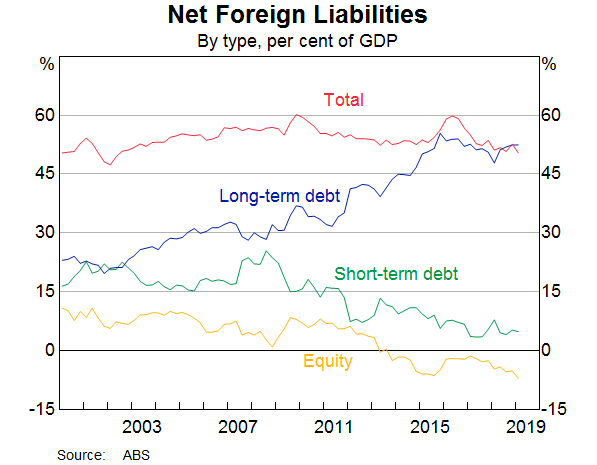
It is important to stress the need to look at the gross flows and stocks, not just the net numbers. There are large capital inflows and outflows all the time, even when the net capital flow (or the current account deficit) is low. As a result, the gross stocks can change quite significantly even with low net flows.
Debt
On the liability side, there has been a large shift from short-term debt to long-term debt. In net terms, long-term debt liabilities are currently 52 per cent of GDP. They are slightly larger than Australia's total net foreign liabilities. They have risen from around 25 per cent of GDP in the early 2000s. Over the same period, the share of short-term debt has declined from 20 per cent to be just under 5 per cent of GDP now.
As Graph 3 shows, the movement in the net position masks, as it often does, different dynamics in the gross positions. The decline in net short-term debt is mostly due to the growth in short-term debt assets that we hold. But short-term debt liabilities have also declined from their peak.
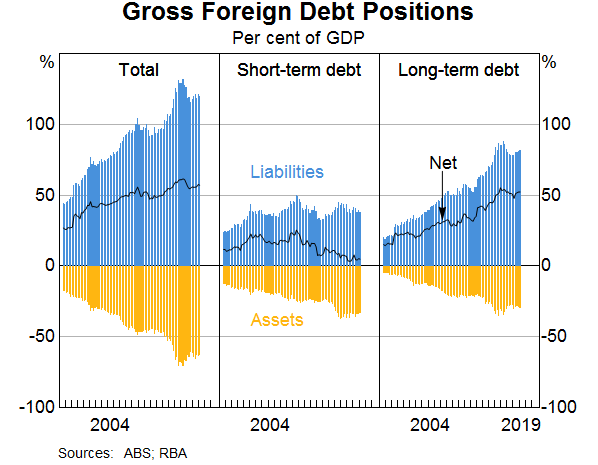
What has been the driver of the increase in foreigners' holdings of Australian long-term debt over the past decade or so? The main explanation has been the large accumulation of Australian public sector debt by foreigners, including by central banks and other public sector asset managers. Central banks increased their allocation to Australia in their foreign reserves portfolios in the aftermath of the global financial crisis. Foreign ownership of Australian Government bonds increased from around 40 per cent in the early 2000s, peaking at nearly 80 per cent in 2012 (Graph 4).[3] At the same time, the size of the Australian Government bond market grew significantly.
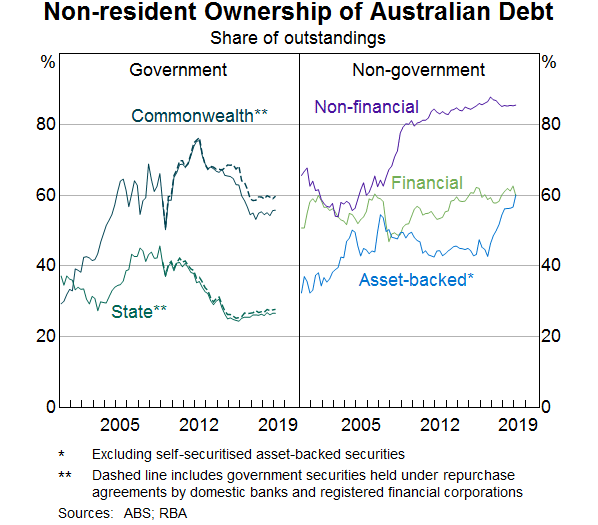
As a result, foreign holdings of public sector[4] debt increased from 7.5 per cent of GDP in 2009 to around 20 per cent by 2015 and has been relatively stable since then. Correspondingly the public sector's share of gross debt liabilities increased from around 10 per cent in the late 2000s to around 20 per cent in 2012, where it has remained since (Graph 5). At the same time, the share of private financial debt (mainly banks) has fallen since the crisis.
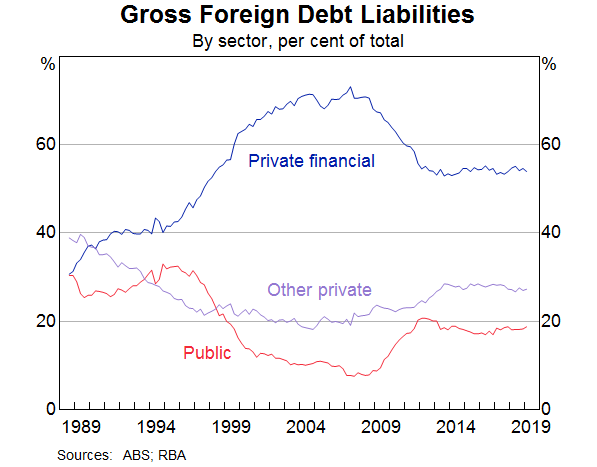
In 2007, the banking sector accounted for the bulk of Australia's net foreign liabilities. Their annual borrowing amounted to around about the same size as the current account deficit. This led to the misplaced claim that the banks funded the current account deficit, which ignored the other large capital outflows and inflows that were occurring.[5] The banking sector's net flows and stocks were the same order of magnitude as the aggregate net flows and stocks. But this wasn't causal. There were large capital flows occurring in both directions in other parts of the economy at the same time. And on the stocks side, there were other large stocks of debt and equity, both assets and liabilities, which all also contributed to the aggregate net foreign liability position in addition to those of the banking system.
Equity
At least as dramatic has been the shift in the net equity position. For most of its modern history, foreigners owned more equity in Australian companies than Australians owned in foreign companies. But since 2013, that has not been true. Since 2013, Australians have owned more foreign equity than foreigners have owned Australian equity (Graph 6). This largely reflects the significant allocation to foreign equity by the Australian superannuation industry together with the fact that the superannuation sector is relatively large as a share of the Australian economy.
Currently, Australian equity investment abroad exceeds foreign equity investment in Australia by 7% of GDP. That is, the country has a net foreign equity asset position. This compares to an average net equity liability position of 10 per cent of GDP between 1990 and 2010.
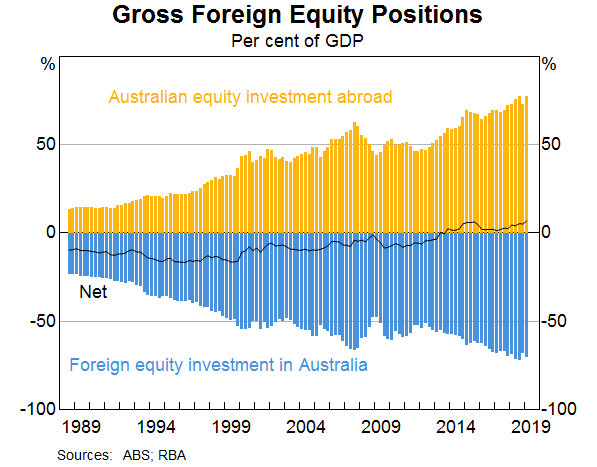
The shift to a net foreign equity asset position reflects:
- the ongoing accumulation of foreign equities by Australia's large superannuation sector (these flows have partially, but not completely, offset continued equity inflows to Australia from foreign investors)
- asset valuation effects, as foreign equities have outperformed Australian equities over the past several years
- the depreciation of the Australian dollar over this period. Because foreign equity assets are denominated in foreign currency, the value of foreign equity assets in Australian dollar terms increases when the Australian dollar depreciates. But the value of equity liabilities, which are obviously denominated in Australian dollars, does not change. So, when the Australian dollar depreciates, the net equity position increases.
This is a major shift in Australia's external position.
Net Income Deficit
Despite the reduction in Australia's stock of net foreign liabilities over the past couple of years, the net income deficit has widened a little, because the average yield that Australia pays on its net foreign liabilities has increased by more than the yield it receives on net foreign assets.
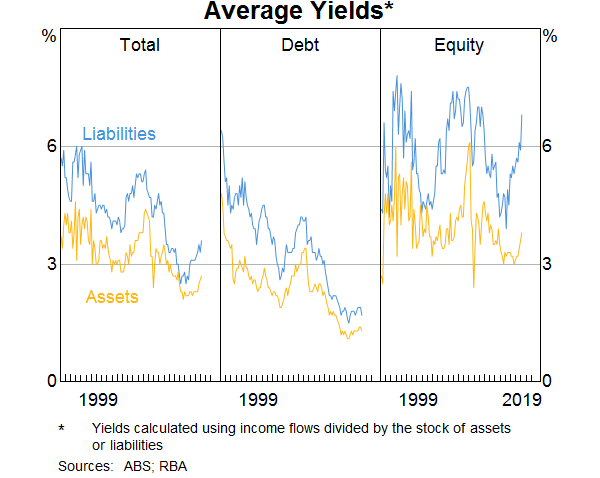
Graph 7 shows the breakdown in the yields we pay and earn between debt and equity and between liabilities and assets.
The graph shows that the main development has been a sharp increase in the payments on foreign equity liabilities. Much of that increase has been due to significantly higher payments recently to foreign owners of direct equity in Australia's mining sector because of the increased profitability of the mining sector. The foreign ownership of the large mining companies is around three-quarters.
Earlier I highlighted how the trade surplus had risen to historically high levels because of higher resource exports. These higher payments to the foreign shareholders limit the narrowing of the current account that occurs from the boost to the trade surplus from this source.
These payments result in ‘notional’ capital outflows because most of the mining companies' profits are earned in US dollars and the distribution of those earnings to foreign owners are also predominantly in US dollars. So these amounts never come onshore into Australia, or are converted into Australian dollars, even though the balance of payments records them as capital flows.
While net equity payments have increased, the servicing cost on the debt liabilities has been little changed in recent years, despite the maturity extension of Australia's net debt liabilities. This is because government debt has lower servicing costs than bank debt and it now comprises a much larger share of the stock of liabilities. Indeed, the cost of servicing overall debt has declined to be its lowest on record. With Australian Government bond yields now materially below those on US yields, the debt component of the net income deficit may decline further still.
Vulnerability?
Foreign debt liabilities are often regarded as a vulnerability. Should we be concerned about this?
In my view, we shouldn't be. Firstly, the vast bulk of Australia's foreign debt is denominated in Australian dollars, not foreign currency. All of the public sector debt is issued in Australian dollars. The debt that is denominated in foreign currency, which is issued by the banks and corporates, is hedged back into Australian dollars (and generally the hedge is maturity-matched). Where it is not, there is often a natural hedge available in the form of foreign currency income.
As a result, the vast bulk of Australia's foreign debt liabilities are in Australian dollars, especially once you take into account the hedging. Moreover, all of the equity liabilities are in Australian dollars too. To put some numbers on this, 68 per cent of foreign liabilities are denominated in Australian dollars, this increases to 85 per cent after hedging.
Historically, a high level of foreign liabilities has been seen as a cause for concern. A number of countries have got into serious trouble because of high foreign liabilities, particularly debt. But in almost every case, the root cause has been the currency exposure. The countries that have got into trouble have had high level of foreign debt denominated in foreign currency. The latter has been the crucial source of vulnerability. It means that the exchange rate can no longer play the important role of shock absorber. If a country with a high level of debt in foreign currency experiences a depreciation, the debt rises in domestic currency terms. The country's ability to service and repay the debt worsens. This can lead to sudden stops, that is, an immediate cessation of capital flows, as investors try to withdraw. These are the archetypal currency crises of Latin America and the Asian crisis.[6]
This isn't an issue for Australia because of the currency composition. The exchange rate depreciation can play the important role of shock absorber, as the experience in the Asian crisis and again in 2008 and 2009 demonstrated. But it took some time to convince external observers of this. To demonstrate that the currency composition of the foreign liabilities wasn't a vulnerability, the RBA commissioned a survey from the ABS to measure this. The first of these surveys was in 2001, and we have continued to get the ABS to repeat the survey every three years. These have shown a consistent picture of minimal foreign currency exposure, including in the most recent survey in 2017.[7]
A large share of Australia's foreign assets are denominated in foreign currency (86 per cent, which declines to 63 per cent, taking account of Australian investors hedging their foreign currency assets). So, if you look at the balance sheet of the country as a whole, Australia has a net foreign currency asset position. This is true on an unhedged and hedged basis (Graph 8). Hence when the exchange rate depreciates, the value of net foreign liabilities actually declines rather than increase.[8]
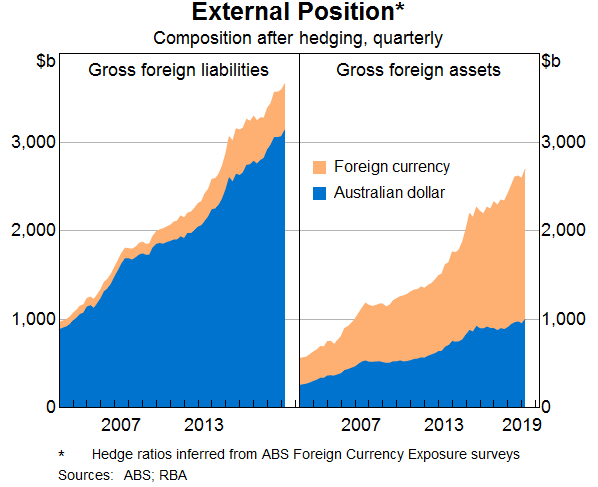
To reiterate, this allows the exchange rate to play the important role of shock absorber to external shocks. The exchange rate's ability to do so is not compromised by Australia's net foreign liability position. The fact that the liabilities are effectively denominated in Australian dollars while the assets are in foreign currency does not impede the exchange rate adjustment. If anything, it actually helps the adjustment. This wouldn't be true if the debt were denominated in foreign currency.
Conclusion
To conclude, Australia's balance of payments and external accounts have undergone a significant transformation since the days of Paul Keating's banana republic comment. The transformation has been quite dramatic and often overlooked. I have highlighted some of the most noteworthy developments. The trade surplus is around its largest, and the current account its narrowest, as a share of GDP in many decades.
On the capital account, the mirror image of the current account, there has been a significant change in both the composition of the capital flows and, as a result, the stock of foreign liabilities and assets. Government debt now comprises a much larger share of debt liabilities and bank debt a smaller share. The maturity profile of that debt is much longer. On the asset side, the large increase in Australian offshore equity investment, mostly through the superannuation sector, means the country as a whole has a net asset position in equities. The structure of Australia's external accounts now resembles that of the United States. While Australia doesn't have the exorbitant privilege of the US, the external accounts do not constitute a source of vulnerability and have become increasingly resilient over the past 30 years.
All of these developments have taken place under the rules-based global trading system that has been in place for a number of decades now. Despite some flaws, that system has delivered sizeable benefits for global growth and welfare. Australia has clearly been a major beneficiary of that system. The current threats to the system are a significant risk to both Australia and the world.
Endnotes
Thanks to Dana Lawson, Emma Smith, Isabel Hartstein and Jarkko Jaaskela for their assistance. [*]
John Pitchford was one of the main contributors to the debate at the time. See Pitchford J (1989), ‘A Sceptical View of Australia's Current Account and Debt Problem’, Australian Economic Review, 86, pp 5–14. [1]
The current account isn't the only determinant of whether net foreign liabilities rise or fall as a share of GDP. That also depends on the growth of nominal GDP and the servicing cost on those liabilities. [2]
The foreign ownership share has declined in recent years. Foreigners have continued to buy public debt, just not in the same share as it has been issued. This share is adjusted for holdings under repo. This adjustment currently affects the ownership share by around 4 percentage points. I think it is better to add back the holdings under repo as it gives a better sense of actual foreign ownership. See Becker C and P Rickards (2017), ‘Secured Money Market Transactions: Trends in the Australian Repo Rate’, Paper presented at the 22nd Melbourne Money and Finance Conference ‘Evolutionary Trends in the Australian Financial Sector’, Hosted by the Australian Centre for Financial Studies, Melbourne, 10–11 July. [3]
This includes the Commonwealth and state governments, central borrowing authorities and public non-financial corporations, but excludes the RBA. [4]
Debelle G (2014), ‘Capital Flows and the Australian Dollar’, Address to the Financial Services Institute of Australia, Adelaide, 20 May. [5]
See R Dornbusch, I Goldfajn and R Valdés (1995), ‘Currency Crises and Collapses’, Brookings Papers on Economic Activity. [6]
See L Berger Thompson and B Chapman (2017), ‘Foreign Currency Exposure and Hedging in Australia’, RBA Bulletin, December, pp 67–75. [7]
Gourinchas, P-O, and H Rey. ‘International Financial Adjustment’. Journal of Political Economy, 115:4, pp 665–703, August 2007. Gourinchas, P-O, and H Rey. ‘From World Banker to World Venture Capitalist: US External Adjustment and the Exorbitant Privilege’, NBER Working Paper 11563. [8]